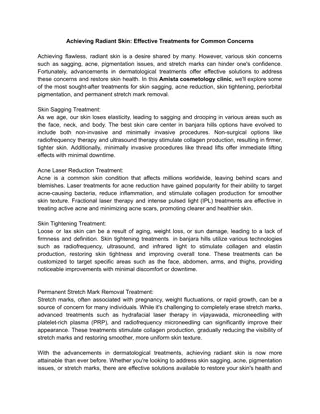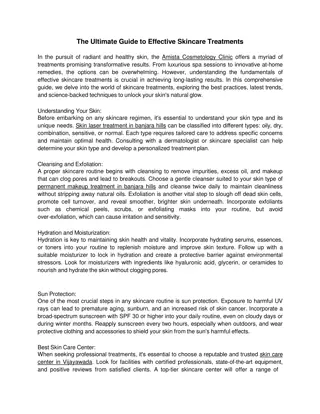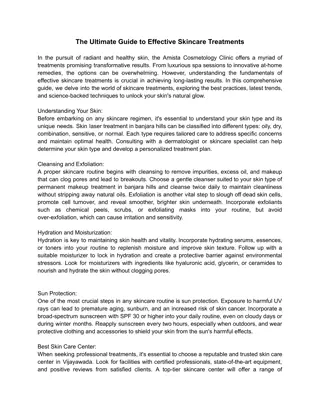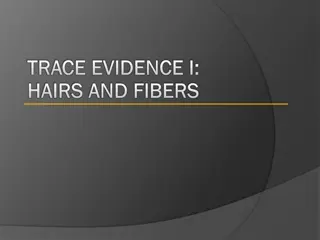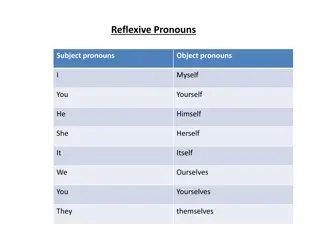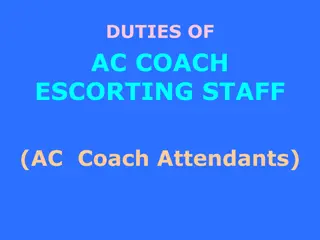Individualizing Treatments for Reflexive Conditioned Motivating Operation
Understanding the importance of individualizing treatments for escape/avoidance behaviors in individuals with ASD. Factors such as behavior change speed, alternative repertoires, and aversive stimuli considerations are crucial for effective intervention. Generic interventions may not address behavior functions effectively. FBA and DRA assessments help in identifying behavior functions and developing targeted replacement behaviors. Challenges with escape extinction highlight the need for careful planning and consideration of social validity in behavior interventions.
Download Presentation

Please find below an Image/Link to download the presentation.
The content on the website is provided AS IS for your information and personal use only. It may not be sold, licensed, or shared on other websites without obtaining consent from the author.If you encounter any issues during the download, it is possible that the publisher has removed the file from their server.
You are allowed to download the files provided on this website for personal or commercial use, subject to the condition that they are used lawfully. All files are the property of their respective owners.
The content on the website is provided AS IS for your information and personal use only. It may not be sold, licensed, or shared on other websites without obtaining consent from the author.
E N D
Presentation Transcript
Individualizing Treatments for the Reflexive Conditioned Motivating Operation Steve Ward, MA, BCBA Whole Child Consulting, LLC www.wholechildconsulting.com http://www.facebook.com/wholechildconsulting
Escape/avoidance behavior is important and common Iwata, et al, 1994 (38.1% of SIB maintained by escape/avoidance) Love, Carr & LeBlanc (2009) identified escape/avoidance as a function of problem behavior for 50% of students diagnosed with ASD
True individualization requires consideration of: The importance of speed of behavior change The strength of alternative repertoires The strength of foundational repertoires The specific reason(s) that a stimulus compound is aversive The relative efficiencies of targeted increase and decrease behaviors Knowing that the function is escape is not enough
Generic interventions Stop light system (3 marks and you go to the office) Time outs Token economies* *These interventions aren t always bad , but they are generic in the sense that they are not related to the function of the behavior.
FBA and DRA Behavior ANALYSTS assess the functions of behaviors, and we love to use DRA s. FBA suggests that Ethel s biting is maintained by escape. What 2 components do we need for the DRA? 1) ____________ 2) ____________
Inspiration for todays paper (LRC templates) Target Behavior Function Replacement Behavior Spitting Escape/avoidance Request break Cursing Escape/avoidance Request break
Problems with escape extinction Creates context potentially evoking more intense resistance May condition task and teacher as aversives (which is contraindicated for populations with deficits in social interest) Very unlikely to lead to spontaneous behaviors Social validity and child effects (McConnachie & Carr, 1997) (many lack the stomach to do it properly and think you re abusing kids)
Problems with teaching break (FCT) Minimizes opportunity to learn that work isn t bad (Roby I don t want to play example) Unhealthy chains? (protest prompt break mand provide break) Needs to get put on DRL, or become gradually less efficient, or protest the first time break is denied will be just as bad as before you started teaching break
Decreasing escape-maintained behavioral excesses Much of the published literature, to date, has focused upon decreasing excesses associated with demands, such as aggression, property destruction, and SIB. That s good, but also only part of the story.
Our students need more Our official goals are to: Teach meaningful repertoires as effectively/efficiently as possible, and Avoid threats, bribes, coaxing, and nagging, and Allow natural (or at least non-intrusive) consequences to do as much of the work as possible, with much more emphasis on positive than negative, in order to Minimize problem behavior and earn 95% quality cooperation
Condition work as reinforcer We want this, as a general approach, and it is sometimes achievable with this sequence: 1) Noncontingent reinforcement 2) Manding and play 3) Demand fading in between mands and play
Differential Negative Reinforcement of Alternative Behavior (DNRA) Problem behavior is put on extinction (or reinforced relatively inefficiently) and cooperation is reinforced more generously (especially with escape, but hopefully also with *positive reinforcers, e.g., Piazza, et al, 1997) We use this a lot, as the issue of escape- maintained behavior is best tackled in the positive i.e., in what situations does ____ tend to cooperate? Let s start there and build a history of cooperation.
We look at individual challenges AND the whole learner Ted almost never cooperates with instructions, but also has no functional mand repertoire. Maybe we should be working on manding first? Jill doesn t like having her haircut, but is generally cooperative outside of that. This is probably an actual problem with haircuts, and she could probably use calm counts .
Another example Ruby doesn t like haircuts, but also hates daily hygiene activities, language-building activities, academics, social play, and chores. She probably doesn t have a haircut problem , but has an overall cooperation problem in the molar sense. We don t know, yet, where we need to begin addressing this, but at least we know it s not a haircut problem.
The thing to be avoided The Reflexive Conditioned Establishing Operation (Michael, 1993) became the Reflexive Conditioned Motivating Operation (CMO-R) (Laraway, Snycerski, Michael & Poling, 2003) The CMO-R establishes its own removal as a form of reinforcement
Increase behaviors vs. tolerance (DNRO) Nail clippers and reading comprehension materials may each function as CMO-R s. We ve done full presentations on calm counts and other treatments of stressors, and that powerpoint is available for free on our website. www.wholechildconsulting.com So, although coughing, clapping, phone conversations, etc., may function as CMO-R s, I m not going to talk about them today.
Why does your student want to escape/avoid? Atty really prefers free operant, especially with travel. Jon hates slow task presentation and Ben hates fast presentation. Some students hate difficult tasks and others hate easy ones (Carr, Yarbrough, & Langdon, 1997)
Some Common CMO-Rs Failure/corrections Lengthy tasks Confusing expectations Difficult output channels Low rate of opportunity for active responding
CMO-Rs can be ideosyncratic (McComas, et al, 2000) For example, some students: -crave prompts and others loathe them, and it may depend upon the type of prompt -prefer either a fast pace or a slow pace -hate fine motor activities -dislike travel
Antecedent strategies Great way to potentially put a student in touch with reinforcement for cooperation. *Probably not the end of the story.
McComas, Hoch, Paone & El-Roy (2000) Some students disliked: repetition of tasks (ceased repetition of tasks) Novel or difficult tasks (cooperation earned through manipulatives, prompt hierarchy i.e., escape extinction) One student did better when provided with a choice. (*We ve had a few students who were furious when provided with choices.) Problem behaviors earned FR:1 escape, but still improved when antecedents were arranged favorably.
Moore & Edwards (2003) Evaluated curricular revision in a general education classroom For 2 students, social aspects of demands functioned as aversives. 2 did better with high attention and the other 2 did better with low attention. For the other 2 students, task difficulty was of primary significance.
Dunlap and Kern (1996) Eddie did better with a series of short tasks than he did with one longer task. So, his work was arranged in short tasks. (*This was one of many treatment components.)
Dunlap, Kern-Dunlap, Clarke, & Robbins (1991) Fine motor vs. gross motor Long tasks vs. short tasks Arbitrary vs. functional tasks Choice
There is also empirical support for: Routines-(Lalli, Casey, Goh, & Merlino, 1994) Fast-pace task presentation-(Carnine, 1976) Demand fading-(e.g., Heidorn & Jensen, 1984) Errorless teaching-(e.g., Weeks and Gaylord Ross, 1981) Visual schedules (e.g., Connis, 1979; Flannery & Horner, 1994)
Antecedent interventionsgood? So we should do all of those things? Maybe, sometimes
Smith and Iwata, 1997 Antecedent Influences on Behavior Disorders Antecedents develop their effects by virtue of the consequences following various behaviors in their presence. Many studies of antecedent interventions fail to provide detailed accounts of consequences of inappropriate behaviors (escape extinction sometimes necessary). *We usually use a modified version of escape extinction that we call a wait out .
Antecedent manipulations rarely drive task resistance to immediate zero levels Rip in the space-time continuum? Teacher direction Student resistance
Pre-cooperation conditions: Continuum of intrusion Most intrusive Least intrusive Hand-over- hand escape extinction Contained within work room, verbal and gestural reminders, but no HOH Contained within work area. No reminders* to cooperate. Allowed to leave work area, no reminders to return to work. 1-3 potential reinforcers withheld. Positive attention provided to cooperative peers (contingent attention) (e.g., Iwata, Pace, Kalsher, Cowdery & Cataldo, 1990) Piazza, Moes, and Fisher (1996) Current study- Ward, Parker, Grimes, & Perdikaris,(201 6?) ( The Timeout Ribbon , Foxx & Shapiro, 1978) (e.g., Madsen, Becker, & Thomas, 1968)
Real world 10% quality cooperation and a ton of crappy behavior? Make believe
Maybe that looks like this Expectations Supports Behavioral outcomes 4 pages of reading comprehension, requiring written answers None Ignored specific instructions Listen to specific instructions Wrote a few related words sloppily on a few lines Remember to put name on paper Spent remaining free time throwing spitballs
Maybe you should dial it down? . Real World 50% quality cooperation and minimal crap behavior Make believe
It could look like this Expectations Supports Behavioral outcomes 3 pages of reading comp Word bank provided Finished 2 pages pretty accurately Asked for help on the 3rd page Listen to brief instructions Teacher catches student working well approximately once per minute Write name on paper Instructions also written on worksheet No time remaining for spitballs
Treatment selection isnt just empirical, but also emotional
We can replace that with: Pragmatic selection of some supports Consideration of relative efficiencies
CMO-R and Concurrent Schedules of Reinforcement . Teacher puts shapes in? Removal of shape sorter becomes effective reinforcer Shape sorter gone, and hopefully additional rf Shape sorter gone and comfort added?
The Matching Law Zone out (passive resistance) Put shapes in Cry (active resistance) Too much help? A little success, but mostly with excessive assistance Results in breaks or excessive assistance? Results in other reinforcers? History? Efficiency? Somewhat slow, but easier than putting shapes in Inefficient (requires looking, gripping, turning) Pretty quick reduction in challenges Eventually has task removed and perhaps insignificant difference in rf compared to putting shapes in? Task goes away and some form of positive reinforcement? Sensory breaks? Drinks? Reinforcer
Geiger, Carr & LeBlanc (2010) Great job of considering presence of (and efficiency of) alternative repertoires, levels of problem behaviors, and feasibility of ambitious treatments (vs. the need to be conservative). Pragmatic/ethical consideration of whether current curricula are appropriate.
Assessing which factors are most relevant to cooperation
The IGLR can be used to assess student performance With and without schedules, tokens, or teacher proximity With boring/interesting material 1:1 vs. group Fast pace vs. slow pace Tangible vs. conditioned rf vs. escape Across learning channels Free operant vs. restricted operant With and without travel Long vs. short tasks Much more
Scoring The Inventory of Good Learner Repertoires Available for free download: www.wholechildconsulting.com
What, exactly, do you want to accomplish, and is it feasible? Strategies for avoiding or minimizing CMO-R Student aversion (CMO-R) Strategies for teaching student to overcome aversion Pivotal learner repertoires impacting long- term stability Slow pace of instruction Emphasize fast- paced instruction Rf calm waiting, responsiveness to slow paced instruction (more than for fast paced instruction), Calm waiting, attentiveness during delays in opportunity to respond, self- calming, appropriate mands Difficult tasks Emphasize easy tasks (e.g., Cameron, Ainsleigh, & Bird, 1992) Present difficult tasks with timely support, rf difficult tasks more than easy tasks, wait outs (or escape extinction) Perseverance, problem solving, appropriate mands for assistance (before protesting but after reasonable effort)
A few more Student aversion (CMO-R) Strategies for avoiding or minimizing CMO-R Strategies for teaching student to overcome aversion Pivotal learner repertoires impacting long-term stability Confusion Practice only mastered tasks, use errorless teaching, provide visual schedules Allow for (or contrive) some confusion and provide well-timed supports. Playing Hotter/colder can be one good exercise. Teach what to do when you don t know what to do ; Mand information or clarification; problem solve; self-calm Gestural prompts Refrain from the use of gestural prompts Contrive favorable circumstances (e.g., Dollar Hunt ). Use during work, but rf prompted responses more than independent responses Learn to respond as independently as possible, but also to appreciate timely prompts (even to ask for them, such as by contriving mands for where? )
Fixing BIP templates Target behavior Function Alternative behavior? Abolishing operation? Indirectly related repertoires? Spitting, cursing Escape, avoidance Cooperation* Demand fading, choices between various easy tasks Establish token economy, teach bragging , mands brought under stimulus control of completed tasks
Does it have to be that complicated? Not necessarily




